
In this week’s article, Dr. Julie Buzby, integrative veterinarian and founder of Dr. Buzby’s ToeGrips®, discusses how to keep your dog healthy and happy during quarantine. Get five DIY dog healthcare tips that will help your dog in pandemic life and beyond.
I fielded a frantic phone call this week from a client about her limping dog. We walked through a detailed history, she answered my questions, and even texted me a video of her Cocker Spaniel ambling around her kitchen. I felt confident this was not an emergency and told her so. I made a few recommendations, but warned that if there was no improvement in 48 hours, we’d have to get together in person…
But I had to preface my recommendations with, “Well under normal circumstances, I’d recommend X, but in light of our current circumstances, I’m recommending Y.” I find myself offering that narrative more and more as the corona quarantine drags on.
Veterinary services: essential and non-essential
Veterinarians are deemed “essential”, so most veterinary hospitals are still open for business, but not necessarily serving up “standard veterinary fare.”
Related post: Navigating COVID-19 with Your Dog: 5 Coronavirus FAQs
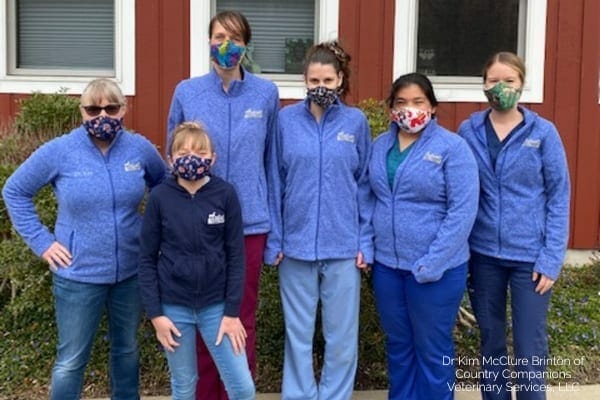
In many states, veterinary hospitals are precluded from providing services that are considered non-essential during the COVID chaos. This means vets are giving a lot more triage and advice over the phone, which has led to the explosion of veterinary telemedicine.
Related post: Veterinary Telemedicine: COVID-19 Ushers in a New Era for Dog Care
If you’re reading this article, I’m going to go out on a clairvoyant limb and peg you as a conscientious, proactive, savvy pet parent. You’re not afraid to clean your dog’s ears, handle your dog’s paws, and fish out forbidden foreign objects from the back of your dog’s throat while he’s trying to gulp them down. You are part “DogGyver”, and I applaud you.
How to keep your dog healthy and happy: 5 DIY tips
So let’s talk about how to keep your dog healthy and happy during the COVID quarantine with these five DIY dog care tips.
#1 Nail trimming—don’t roll your eyes!
I have seen some creative memes in my private veterinary chat groups about clients requesting nail trims and veterinarians unable to deliver.
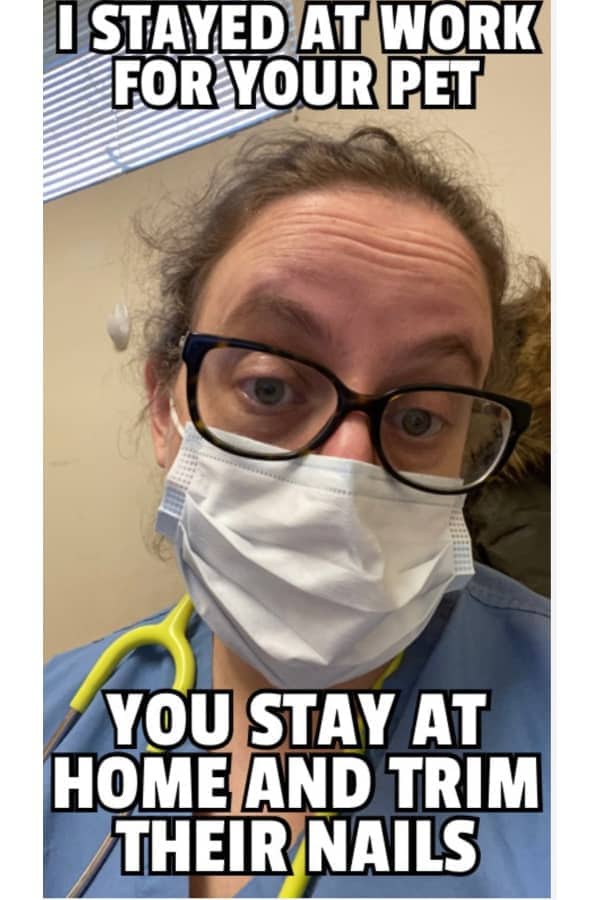
Dog nails, like our nails, grow continuously. Although there’s certainly something to the fact that when dogs exercise, especially on rough surfaces, their nails may tend to wear down a bit. For the most part, our dogs aren’t traversing rough terrain in Nepal. The average four-legged canine couch potato has ever-lengthening nails and needs them trimmed every couple of weeks or so. (Every month would be the extreme outer limit of what I would consider an acceptable interval.)
So guess what? We’ve been in COVID quarantine for over a month and this means that just like all of us who have two inches of grey roots and are frantically searching for a used Flowbee on eBay, dogs have some “hygiene and maintenance” concerns in this pandemic too—namely, long toenails.
And I cannot stress enough that long nails are not just a cosmetic issue. Granted, the reason people might be bothered by their dog’s talons is that it kind of looks creepy…
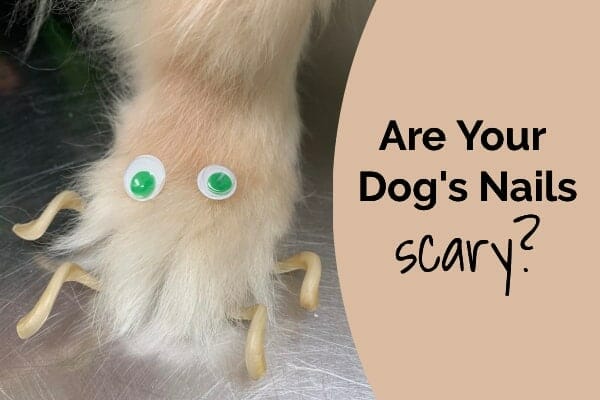
Or maybe they’re realizing that dogs with long nails are more likely to accidentally scratch their humans.
Or maybe they’re frustrated because their dog is clicking around on their floor at night and keeping the family awake. All valid concerns, but not why I’m about to get on my soapbox…
Long nails are more than a cosmetic issue
When dog nails are too long, it impacts their posture. It affects the way their toes interface with the ground. It affects the dog’s gait. Every single stride is affected. Think about what it would be like for you to wear shoes that were three sizes too big. This would absolutely impact your stride and your gait. And the same is true for dogs with long toenails. They have to compensate for that.
Another issue is dogs with long toenails are more likely to break a nail. This sounds ludicrous, like the type of thing only supermodels need to fret over, but, in fact, it’s an issue for dogs too!
Broken bleeding toenails are not an uncommon veterinary “emergency.” And it’s a big bloody mess. The toenail may be totally ripped off and dangling or it may just be split open. Either way, it’s extremely painful for the dog because there’s raw exposure of the quick—the blood and nerve supply. And this does require veterinary care. It’s my strong opinion from experience that by keeping your dog’s nails shorter, you decrease the odds of this happening.
In some states, vets can only provide “medically necessary” procedures
So what if you totally get it, and you’re on board with the importance of nail trims, but your vet and groomer are closed. This was recently posted on the Facebook page of a veterinary hospital in Florida:
Let’s talk about nail trims!!! We are getting a lot of calls requesting appointments for nail trims only. As an essential service provider, the governor and the FVMA have given us clear directives: Veterinarians are only to provide medically necessary procedures until further notice. Therefore, unless there is a medical problem involving a pet’s feet/nails, we cannot make an appointment just for a nail trim. Unfortunately, we have had several clients become belligerent on the phone with our staff members when we explain the current limitations of our operations. ? Please understand that we are doing the best we can in these unprecedented times, just like everyone else. Please try to be kind, despite the inconvenience.
Fear not, we can help! We’ve got just the DIY solution!
I am considered a weirdo in the veterinary space because I really love trimming dogs’ toenails. So much so that I created an entire e-learning course, Dr. Buzby’s Nail Trimming Without Blood, Sweat, or Tears!
I don’t want this to sound like a sales pitch—this is not one of those “act now and you’ll also get a free Ginsu knife” stunts. I wholeheartedly believe this step-by-step e-learning course will help guide you through everything you need to know about nail trimming including the following: how to best hold your dog, how to make the experience as pleasant as possible, and how to avoid the quick.
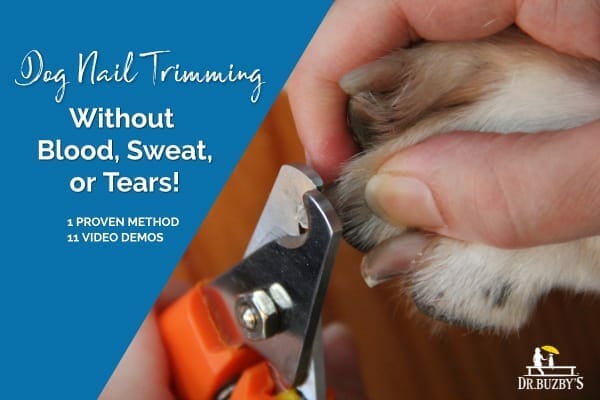
I want to get this resource to you so badly that I’m offering it for 60% off until April 30, 2020. Use promo code WAGS to take the course (and have lifetime access) for $39.
One way or another, please keep up with your dog’s nail trims the best you can during the quarantine.
#2 Human medications & home remedies
Number two is more of “what not to do.” Thinking back to my Cocker Spaniel owner and her limping dog, she could have made a fairly minor problem much, much more serious is if she’d decided to administer something out of her own medicine cabinet.
I cannot comprehend why doggy aspirin is sold on the market. I’ve seen it on the shelf of big box stores and I don’t get it…at all. I would never give aspirin to a dog, or Tylenol, or ibuprofen. Now, there are some appropriate uses of Tylenol with Codeine for pain control in dogs. But now we’re talking about a specialized use, titrating pain meds when maybe traditional things have not worked. This is not a “go-to” medication by any means.
Trust me, you do not want to give human medications to your dog unless you want to be on the phone with animal poison control or at your vet’s office with an emergency. Let’s avoid that.
However, what if this spring you’ve realized that your senior dog is slowing down? At some point, a veterinary visit is wise for a complete physical exam, bloodwork, and anything else your vet deems appropriate. In fact, unlike younger dogs who should go to the vet for annual exams, senior dogs should be examined twice a year so problems can be caught and addressed early.
If your dog is slowing down a bit yet still acting himself in every other way, that’s not an urgent issue. You may just be wondering, “Are these normal signs of aging or could my dog have arthritis and be in pain?” Since you likely have more time on your hands right now for reading and research, you may appreciate my article, Is it Canine Arthritis or Aging? Learn 7 Signs of Arthritis in Dogs. It will help you sort through the signs of arthritis versus aging in your beloved dog.
And in the spirit of DIY “home remedies” for helping your aging dog truly be “safer at home,” I’d also recommend 7 Senior Dog Care Tips: Keeping Your Dear Old Dog Comfortable.
#3 Calories, exercise, weight management
For me, part of being home ALL THE TIME is that I find myself spending more quality time with my refrigerator. So my new quarantine figure and gravitation toward spandex is my own fault.
But remember, your dog can’t open the refrigerator. So if your dog is overweight, which two-thirds of American dogs are, then it’s not his fault. He’s at the mercy of the exercise that you provide and the calories that you feed.

I would encourage you to be really cognizant of the fact that it’s hard, especially for senior dogs, to get the weight off. If a dog already struggles with mobility issues, the extra weight can be absolutely crippling, in a very literal sense. Those extra pounds are harder to lift off the ground when they go to get up and harder to lug around the house. And that’s why weight management is perhaps one of the most common sense things you can do for your dog during quarantine. Those few extra calories from sharing your meals and snacks add up quickly for little dog bodies who only need a fraction of the calories the human body needs in a day to maintain body weight. Any extra calories get converted to fat stores in the body.
#4 Learn ten touches that could save your dog’s life

As you know, animals don’t speak in words. Certainly, they do speak volumes with body language and posture and facial expression, but they don’t speak the English language. We are to be their advocates, their voice, and it’s a very serious responsibility for pet owners.
As telemedicine becomes a new standard of care for veterinary medicine, it’s going to become more and more valuable for you to be able to “read” your dog. I am a huge believer that just like women perform self-breast exams to monitor for changes, you should be doing weekly home health scans on your dog to learn his or her “baseline.” You’ll then be able to quickly recognize when there are changes that could be worrisome— whether it be in the color of the gums or a lump under the skin—and reach out to your veterinarian.

When the government teaches secret service agents to identify counterfeit money, they don’t teach them by showing them a bunch of counterfeit money. They teach them with real money—examining it over and over and over, so that when they see a counterfeit bill, it jumps out because they have such a keen sense of normal.
And that’s what I’m asking you to do with your dog. It’s not a coronavirus-specific skill, but there’s no better time than today to commit to the habit of doing these weekly “inspections.” I walk you through the 10 touches and how to do them in my podcast, 10 Touches That Could Save Your Dog’s Life. Plus, it is coming soon in ebook too!
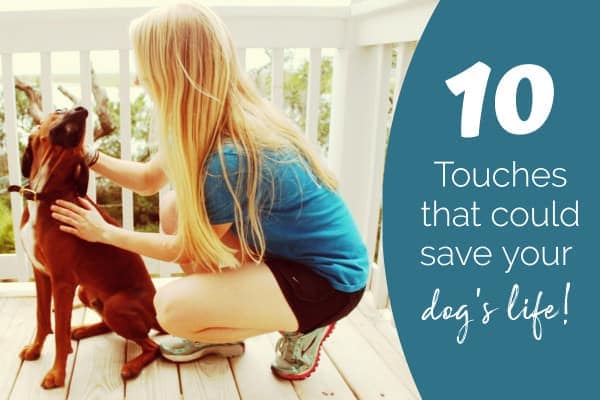
In addition to the value of this skill for wellness checks, it will also prove to be a superpower if your dog gets sick. If you were to begin a message or conversation with your veterinarian by providing your dog’s temperature, pulse, and breathing rate, I guarantee you’d instantly earn “client of the year” status. These parameters would be so helpful to your veterinarian in triaging your dog because most anything else you say is going to be subjective (shades of grey interpretation). In contrast, your dog’s temperature, heart rate, and respiratory rate are black and white indicators of health.
Every dog owner can and should learn how to track their canine companion’s vital signs as an important life skill in keeping their dog healthy. You can learn how (and find a quick reference chart of “normal values”) in my article, From Dog Respiratory Rate to Heart Rate: Keeping a “Pulse” on Your Dog’s Vital Signs.
#5 Your vet is best. But here’s plan B…
Your veterinarian knows your dog best. The relationship you share has a fancy legal name: the veterinary-client-patient-relationship (VCPR). It gives your vet special legal privileges in making recommendations for your dog.
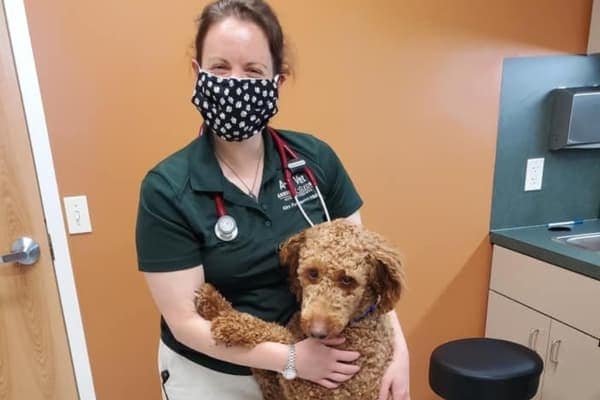
But I get that your vet is not available 24/7. And especially during COVID-19 season, it’s even more complex.
So, in addition to whatever after-hours emergency hospital your regular vet suggests, I recommend the free “pet symptom checker” from the telehealth platform, Petriage, available as a mobile app for IOS or Android. The app allows you to input your dog’s signs and severity to quickly receive a rating of “emergency, urgent, worrisome, or non-threatening.” This instant triage information is invaluable, and I think every pet owner should have this app on their phone.
Similarly, there are several companies that offer live chat with a veterinarian for triage. Recently, Royal Canin announced a partnership with Ask.vet, a telehealth website. The two companies are partnering to provide free chat for support for pet owners during the pandemic. This is another valuable service, in that pet parents can chat with a veterinarian in real time, and it’s presently FREE! Just be aware that because you and this veterinarian will not have a VCPR, the advice will be more generic than specific. For more information, please go to Royal Canin’s website and read, Free Chat with a Veterinarian 24/7.
Dog care during COVID-19 and beyond…
No one knows what the future holds on this rollercoaster ride called COVID. But hopefully, I’ve shared a few ideas, tools, and resources to help make the journey for you and your dog a little smoother, healthier, and happier. During the days of quarantine and beyond, may you always find peace, love, and strength in caring for your beloved grey-muzzled companion.


We welcome your comments and questions about senior dog care.
However, if you need medical advice, diagnosis, or treatment, please contact your local veterinarian.